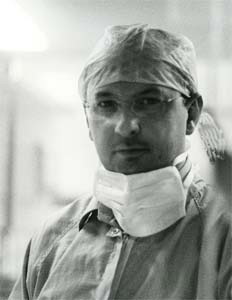Professor Adrian J. Thrasher
The Science article Gene Therapy Cancers Prompt Design of Safer Virus said
“The announcement last month that a fifth child who received gene therapy for an immune system disease has developed leukemia was the latest blow to the field of gene therapy. But there’s new hope: The U.K. team running the trial reports this week that a safer formulation of the treatment can cure the disease in mice and should also work in people.Gene therapy’s clearest success to date has been restoring the health of about 40 children with severe combined immunodeficiency (SCID), also known as ‘bubble boy’ disease because patients cannot fight off infections and are often isolated to protect them from germs. The treatment had a down side, however: Since 2002, four of 10 children in a French trial for a form of SCID involving a defect on the X chromosome (X-SCID) have developed leukemia, apparently because the retrovirus used to insert a curative gene into patients’ blood stem cells turned on a cancer gene. Researchers at the Institute of Child Health at Great Ormond Street Hospital in London were conducting a nearly identical X-SCID study without serious side effects, and some researchers suspected that their technique was somehow safer. But in mid-December, one of their patients also developed leukemia.
Now the U.K. team says it has found a better approach. The problem with the virus used in the U.K. and French studies seemed to be its powerful promoter, a stretch of DNA that regulates expression of the inserted gene, IL2RG. This promoter also apparently turned on a nearby cancer gene. To eliminate this problem, U.K. study leader Adrian Thrasher and colleagues replaced the promoter with one less likely to turn on other genes. This ‘self-inactivating’ retrovirus also cannot make more copies of itself once it has stitched itself into the host genome. In vitro studies on self-inactivating vectors, including a recent paper by this group comparing the growth of cells treated with their new vector and the old one, are boosting confidence.”
Adrian J. Thrasher, PhD, MD, BS, FRCP, MRCPCH, FMedSci is Professor of Paediatric Immunology and a Wellcome Trust Senior Clinical Fellow in the Molecular Immunology Unit at the UCL Institute of Child Health (ICH). He is also Consultant Clinical Immunologist at Great Ormond Street Hospital (GOSH) and Director of the Centre for Immunodeficiency at ICH/GOSH with clinical responsibilities for care of patients with primary immunodeficiency syndromes. He qualified in medicine in 1986 at St. George’s Hospital Medical School, University of London. He earned his PhD in 1995 at University College London.
Adrian’s research interests fall into two broad categories; the pathophysiology of primary immunodeficiency and the development of somatic gene therapy. His bibliography includes over 145 peer-reviewed publications plus more than 40 invited contributions to scientific journals and books. He has been interviewed on numerous occasions for newspapers, television and radio. In 2002, he received the Sky News Innovation Award and in 2005, was a recipient of the EU Descartes Prize for Research and Science.
He coauthored Essential Role of the NADPH Oxidase Subunit p47phox in Endothelial Cell Superoxide Production in Response to Phorbol Ester and Tumor Necrosis Factor-{alpha}, Restoration of photoreceptor ultrastructure and function in retinal degeneration slow mice by gene therapy, WIP Regulates the Stability and Localization of WASP to Podosomes in Migrating Dendritic Cells, Risks of gene therapy should be weighed against lack of alternatives for many diseases, Configuration of human dendritic cell cytoskeleton by Rho GTPases, the WAS protein, and differentiation, and Gammaretrovirus-mediated correction of SCID-X1 is associated with skewed vector integration site distribution in vivo.
